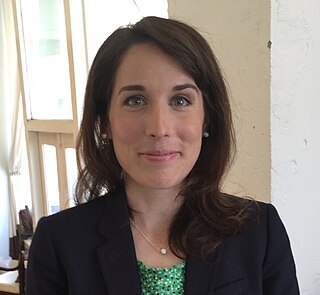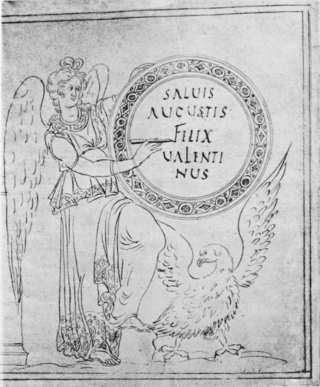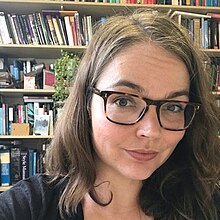Barbara Mary Levick was a British historian and epigrapher, focusing particularly on the Late Roman Republic and Early Empire. She was recognised within her field as one of the leading Roman historians of her generation.

Dura-Europos was a Hellenistic, Parthian, and Roman border city built on an escarpment 90 metres above the southwestern bank of the Euphrates river. It is located near the village of Salhiyé, in present-day Syria. Dura-Europos was founded around 300 BC by Seleucus I Nicator, who founded the Seleucid Empire as one of the Diadochi of Alexander the Great. In 113 BC, Parthians conquered the city, and held it, with one brief Roman intermission, until 165 AD. Under Parthian rule, it became an important provincial administrative centre. The Romans decisively captured Dura-Europos in 165 AD and greatly enlarged it as their easternmost stronghold in Mesopotamia, until it was captured by the Sasanian Empire after a siege in 256–257 AD. Its population was deported, and the abandoned city eventually became covered by sand and mud and disappeared from sight.
Barbara Elizabeth Goff is a Classics Professor at the University of Reading. She specialises in Greek tragedy and its reception; women in antiquity; postcolonial classics and reception of Greek political thought.
Rhiannon Ash is a British classical scholar specialising in Latin literature and Tacitus. She is professor of Roman Historiography in the Faculty of Classics, University of Oxford, and a Fellow of Merton College, Oxford. She was formerly a lecturer at the Department of Greek and Latin at University College, London.
Professor Lynette Gail Mitchell is Professor in Greek History and Politics at the University of Exeter. Mitchell is known for her work on ancient Greek politics and kingship.
Irene J. F. de Jong is a classicist and professor of Ancient Greek at the University of Amsterdam. She is known for her pioneering work on narratology and Ancient Greek literature. She is a Fellow of the British Academy.

Zahra Newby is Professor of Classics and Ancient History at the University of Warwick. She is known in particular for her work on Greek mythology in Roman art and the visual culture of Greek festivals in the Roman east. Newby is currently the Head of the Classics and Ancient History Department at the University of Warwick.

Ida Östenberg is a Roman historian, working in the areas of Roman political culture, Roman rituals, performances and spectacles, and Classical reception. She is known in particular for her work on the Roman triumph, and is an expert selected by the Swedish Research Council for inclusion in AcademiaNet. She is the 2018 winner of the Stora historiepriset, Sweden's largest history prize.

Sarah Emily Bond is an Associate Professor of History at the University of Iowa. Her research focuses on late Roman history, epigraphy, law, topography, GIS, and digital humanities.

Michele Renee Salzman is a distinguished professor of history at the University of California, Riverside. She is an expert on the religious and social history of late antiquity.

The Temple of the Gadde is a temple in the modern-day Syrian city of Dura-Europos, located near the agora. It contained reliefs dedicated to the tutelary deities of Dura-Europos and the nearby city of Palmyra, after whom the temple was named by its excavators. The temple was excavated between 1934 and January 1936 by the French/American expedition of Yale University, led by Michael Rostovtzeff.

The Temple of Bel, also known as the Temple of the Palmyrene gods, was located in Dura Europos, an ancient city on the Euphrates, in modern Syria. The temple was established in the first century BC and is celebrated primarily for its wall paintings. Despite the modern names of the structure, it is uncertain which gods were worshipped in the structure. Under Roman rule, the temple was dedicated to the Emperor Alexander Severus. In that period, the temple was located within the military camp of the XXth Palmyrene cohort.
Olga Palagia is Professor of Classical Archaeology at the National and Kapodistrian University of Athens and is a leading expert on ancient Greek sculpture. She is known in particular for her work on sculpture in ancient Athens and has edited a number of key handbooks on Greek sculpture.
Margaret Crosby was an American archaeologist and historian. Crosby graduated from Bryn Mawr College in 1922, and subsequently became involved in archaeology and ancient history, especially epigraphy and metrology, earning her PhD at Yale University. During World War II, Crosby joined the Office of Strategic Services (OSS) and worked as a cryptographer for the OSS' Greek Desk, deciphering reports and materials for the Allied Forces.
Lea Margaret Stirling is a Canadian classical scholar and professor in the Department of Classics at the University of Manitoba. Her research focuses on Roman archaeology and Roman art with particular emphases on Roman sculpture, Late Antique art, and cemetery archaeology, and Roman North Africa.
Allison Glazebrook is Professor of Greek Social and Cultural History, Gender and Sexuality, and Greek Oratory at Brock University. She was President of the Classical Association of Canada 2018–20.
Nanno (Ourania) Marinatos is Professor Emerita of Classics and Ancient Mediterranean Studies at the University of Illinois Chicago, whose research focuses on the Minoan civilisation, especially Minoan religion.
Beth Severy-Hoven is Professor of the Classical Mediterranean and Middle East at Macalester College. She is an expert in Roman history and archaeology, and gender and sexuality in antiquity.

The Temple of Aphlad was an ancient temple located in the southwestern corner of Dura Europos, and dedicated to the god Aphlad. Aphlad was originally a Semitic Mesopotamian god from the city of Anath, and presence of his cult in Dura is revealing of its religious and cultural diversity. The temple itself consists of an open courtyard with multiple scattered rooms and altars, similar to the Temple of Bel, which was located in an analogous position in the northwestern corner of Dura.
David Lorton was an Egyptologist and translator, most well known for his work translating European research into English.






